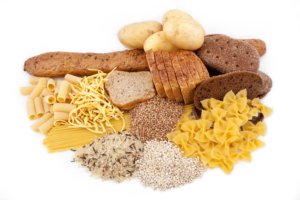Carbohydrates are often the real culprits
 Even though carbohydrates are an important source of energy for the brain, the muscles, and other organs, they often contribute to weight problems.
Even though carbohydrates are an important source of energy for the brain, the muscles, and other organs, they often contribute to weight problems.
A diet with a lot of starchy foods like bread, pasta, grain, potatoes, and rice plus sugar and other refined foods causes your blood sugar to increase violently. The body’s cells get a lot of quick energy, and excess calories are then removed from the bloodstream and stored as fat – typically in the abdominal region.
Understanding the glycemic index (GI) is useful if you want to lose weight and stay slim
The glycemic index (GI) is a measure for the increase in blood sugar levels caused by any given carbohydrate-containing food. The higher the GI value of food, the faster your blood sugar goes up.
This new insight in GI is useful for people who are overweight, for people who have normal weight but have apple-shaped bodies with an enlarged waist circumference, or for those who are insulin-resistant (have problems with taking up glucose in their cells) and wish to prevent lifestyle diseases.
As a rule of the thumb, the GI value of foods increases when you dry them, cook them, or refine them.
The following overview merely serves as a guideline, as the sugar content in fruit, methods for cooking and preparation, and individual differences in metabolic rate can vary a lot. The less fit and physically active you are the more sensitive you are to foods with a high GI. The amount of carbohydrate that is consumed also means a lot in practice – and is called Glycemic Load (GL)
There are different ways to calculate the GI-value for food. To make things easier, one normally talks about high, medium and low GI foods.
|
High GI foods |
Medium GI foods | Low GI foods |
|
cause your blood sugar to rise rapidly and drop soon after |
make your blood sugar levels vary It depends a lot on the amount |
Cause a slow rise in blood sugar levels and help keep your blood sugar stable. |
| White bread, white rice, rice cakes, crackers, cornflakes, baked potatoes, pizza, croissants, corn, parsnips, red beets, raisins, dates, watermelon, cookies, pastry, candy, glucose |
Rye bread, pasta, brown rice, Basmati rice, new boiled potatoes, unsweetened muesli with nuts, banana, orange, grapes, raw carrots, dried apricot, chocolate, unsweetened fruit salad, cream cakes, sucrose (sugar) | Most vegetables and fruits such as beans, cabbage, asparagus, tomato, lettuce, apples, pears, berries, buckwheat, whole kernels, barley, nuts, Jerusalem artichoke, sweets potatoes, milk, fructose (fruit sugar) |







